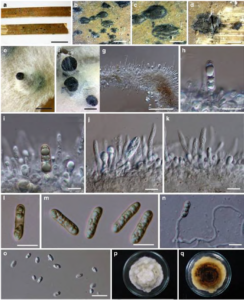Roussoella angustior D.Q. Dai & K.D. Hyde.
Index Fungorum number: IF551344; Facesoffungi number: FoF00903; Fig. 1
Etymology – Refers to the narrow conidia.
Holotype – MFLU 15–1214
Saprobic on bamboo culms, forming darkened spots on the host surface with pustule – like raised conidiomata. Sexual morph: Undetermined. Asexual morph: Conidiomata 1 – 2.5 mm long, 0.8 – 1.2 mm wide, 300 – 500 μm high, eustromatic, immersed in the host tissue, partly erumpent when mature, solitary, scattered, multi – loculate, ellipsoid to wide fusiform, coriaceous. Conidiomatal wall 15 – 30 μm wide, with dark brown to hyaline conidiogenous inner layer, comprising cells of textura angularis. Paraphyses 15 – 35 μm long, 2 – 3.5 μm wide, hyaline, septate, straight to curved. Conidiophores 2 – 6.5 × 2.5 – 3.5 μm (x̄ = 4.4 × 3.2 μm, n = 10), short, cylindrical, smooth, hyaline. Conidiogenous cells 2 – 10 × 2.5 – 3.5 μm (x̄ = 5.9 × 3.3 μm, n = 20), enteroblastic, phialidic, cylindrical to ampulliform, determinate, discrete, smooth, hyaline. Macroconidia 17.5 – 24 × 3.5 – 5 μm (x̄ = 19.6 × 4.2 μm, n = 20), pale brown to dark brown, 1 – septate, cylindrical, obtuse at both ends, occasionally truncate at lower end, smooth, straight, with many guttules. Microconidia 3.5 – 4.5 × 1.5 – 2.5 μm (x̄ = 4.1 × 2.2 μm, n = 20), subglobose, hyaline, smooth, guttulate.
Culture characteristics – Ascospores germinating on PDA within 24 h and germ tubes produced from lower cell. Colonies growing slowly on PDA, reaching 7 mm in 60 days at 28 °C, circular, floccose, with uneven margin, white from above, yellowish brown to dark brown from below. Mycelium immersed and superficial in the media, composed of branched, septate, smooth – walled, hyaline aerial hyphae and verrucose, dark brown hyphae near or within the media, producing a few black conidial masses.
Material examined – THAILAND, Phang-Nga, Doi Nang Hong, Tham Thong Lang, Thap Put District, 8°32′11″N 98°33′35″E, on dead culm of bamboo, 6 December 2014, K.D. Hyde DDQ00286 (MFLU 15–1214, holotype); Ibid. (KUN, HKAS 88721, isotype), ex-type living culture at MFLUCC 15–0186, KUMCC.
Notes – This newtaxon is morphologically and phylogenetically close to Roussoella magnatum in having black, ellipsoid to wide fusiform conidiomata, hyaline, septate pseudoparaphyses and brown, cylindrical, 1-septate conidia. However, R. angustior has narrower (19.6 × 4.2 μm vs. 18.9 × 5.6 μm) and smooth – walled conidia. These two species are phylogenetically separated by the combined genes analyses. Roussoella species usually produce short (not more than 15 μm long), oblong to ellipsoidal conidia (Hyde et al. 1996; Liu et al. 2014). The new species collected by us from bamboo has longer (more than 16.5 μm long), cylindrical conidia. (Crous et al. 2014) described R. acacia with 7 – 10 × 4 – 5 μm conidia from Acacia. Moreover, in these two new taxa, R. magnatum and R. angustior, microconidia and macroconidia are formed in the same conidiomata. Such characters are not reported in other species in the genus Roussoella (Hyde et al. 1996; Crous et al. 2014; Liu et al. 2014).

Fig. 1 Roussoella angustior (holotype) a – c Conidiomata on bamboo culms d Conidiomata after cutting away top part e, f Conidial masses on PDA g Conidiogenous inner layer h – k Paraphyses and conidiogenous cells l,m Conidia n Germinating conidium o Micro-conidia p, q Cultures on PDA after 60 days. Scale bars: a = 5 mm, b, e, f = 1 mm, c, d = 500 μm, g = 50 μm, h – o = 10 μm.
